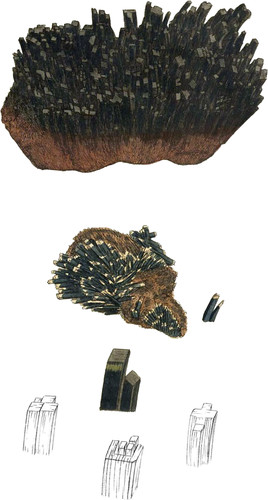 Enlarge
Enlarge
Exotic Mineralogy
- Syn.
- La Yènite. Le Lièvre, Journal des Mines, 121. 65.
- Yènite. Haüy, Tabl. pp. 42. 182.
The first public account of this mineral was given to the French Institution by Monsieur Le Lièvre in 1806, who found it five years before in the Isle of Elba; from his memoir it appears that it had lain in several cabinets (as other minerals sometimes have) among others in that of Romé de Lisle, waiting for some one who had leisure and opportunity to investigate it. Le Lièvre found it in two different spots on the Isle of Elba, Rio la marine, and Cape Calamite, in masses mixed with a green substance resembling Actinolite, and containing Epidote, Quartz, Arsenical Iron, and Magnetic Iron, upon a primitive Limestone containing Talc: at Cape Calamite it was also accompanied by Garnets. It seems from his figures that lie found better crystals than any that I know of in England. Our figures are taken from two instructive specimens in the collction of our scientific friend the Count de Bournon; they present rectangular prisms, in some of which, one of the vertical edges is truncated; in the smaller specimen the crystals are divided at their ends into flexible fibres resembling Asbestos, and in other parts are decomposing into a kind of Ochre. The larger figure shows much variety in the fasciculi of prisms, which, diverging from a solid base of the same substance, are crowded in various fanciful ways; see the lower figures.
The Count possesses also a small specimen in which the crystals are somewhat transparent, and of a dull green colour, hence he observes that the black colour described by Le Lièvre proceeds from the intensity of the green. There have been already two primitive forms ascribed to this substance, the one by Mr. Cordier, in Le Lièvre’s memoir, he states it to be an upright teraëdral prism, with a rhomboidal base of 112°. 37′. 9″. and 67°. 22′. 51″ (parallel to the base of which it is not laminated) this prism is divisible in the direction of the shorter diagonal of the base, Haüy considers a rectangular octaëdron to be the primitive form, two of whose faces measured over the summit of each pyramid include 112°. 36′. the other two 66°. 58′. he also mentions a division of tins octaëdron by a plane passing through its summits, and corresponding to the diagonal one above, but the Count de Bournon observes that nature indicates very clearly that a rectangular prism is the primitive form, one of the faces of which is the same as Haüy has observed to divide his primitive into two parts. The specific gravity, according to Le Lièvre, is from 3.825 to 4.061. the hardness sufficient to scratch glass, but not Adularia. It is easily fusible by the blow-pipe, and becomes attractible by the magnet. Le Lièvre gave the name of Yenite to this substance, in commemoration of the Battle of Jena.
| Analysis by Descotils. | By Vauquelin. | ||
|---|---|---|---|
| Silex | 28 | 29 | 30 |
| Lime | 12 | 12 | 12.5 |
| Oxide of Iron | 55 | 57 | 57.5 |
| Oxide of Manganese | 3 | 57 | 57.5 |
| Alumine | 0.6 | 0 | 0 |
| Loss | 1.4 | 2 | 0 |
| Silex | 20 |
| Lime | 14.8 |
| Oxide of Iron | 49 |
| Oxide of Manganese | 2 |
| Alumine | 1 |
| 96.8 |

